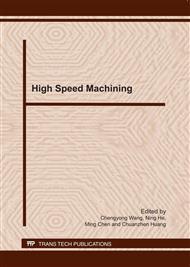p.376
p.381
p.387
p.392
p.398
p.404
p.410
p.416
p.423
Aeroacoustic Performance Evaluation of Milling Cutters Based on the Flow Field on the Cutter Surface
Abstract:
Many workers all over the world suffer significant hearing loss as well as psychological and physical stress as a result of exposure to high levels of aeroacoustic noise. Dipole sources are the major noise sources in aeroacoustic noise generation in rotating face milling cutters. A noise model based on the Ffowcs Williams-Hawkings Equation is used to predict aeroacoustic noise; the noise predicted was 2.5dB less than the experimental observations. Flow field of cutter surface was numerically simulated by the resolution of the Navier-Stokes equations (CFD) and five zones on cutter surface were founded to be the important noise source. The broadband noise spreads over a broad range of frequencies and contributes significantly to overall noise, but the discrete noise at the rotational frequency is usually higher and more detrimental to the body.
Info:
Periodical:
Pages:
398-403
Citation:
Online since:
March 2011
Authors:
Price:
Сopyright:
© 2011 Trans Tech Publications Ltd. All Rights Reserved
Share:
Citation:


